What is Intervertebral Disc | Definition of Intervertebral Disc
Intervertebral disc (IVD) are soft tissues present in between the vertebrae in the spinal column, so that we can bend and twist our back smoothly.
Intervertebral means in the between the vertebrae.
There are 23 discs in our spine,
6 discs in the cervical spine
12 discs in the thoracic spine
5 discs in the lumber spine
No disc is present in the sacral and coccyx region as they are fused.
To understand how disc works, we need to know the components of a disc which make it able to perform those functions.
What are Intervertebral discs made of | Composition of Disc:
There are 3 parts of a disc and these three parts are composed of water, collagen, and proteoglycans (PGs) in different proportions along with many cells, including elastin, proteins, proteolytic enzymes, chondrocytes, and other types of collagen.
1. Nucleus Pulposus(like a water balloon): It is a gelatinous mass found in the center of the disc
a) Composition:
i) 70% to 90% of water,
ii) approximately 65% of PGs of the dry weight, these PGs have an ability to attract water molecules because of the presence of glycosaminoglycans, that’s why the nucleus pulposus has more concentration of water.
iii) 15% to 20% of Collagen fibres of the dry weight, there are two types of collagen fibres type I and type II, both of them has a different function; in the nucleus, type II
collagen fibres are more than type I collagen fibres, which can resist compressive loads.
b) Function :
i) Resist compressive loads due to predominates type II collagen fibres.
ii) When compressed, it deforms its shape and the increased pressure stretches the walls
of the balloon in all directions due to high water content and act as a shock absorber
2) Annulus Fibrosus: it is a fibrous outer ring around nucleus pulpusos and It is attached to the cartilaginous endplates on the inferior and superior vertebral
plateaus of adjacent vertebrae and to the epiphyseal ring region by Sharpey fibers.
a) Composition :
i) 60% to 70% of water.
ii) Only 20% PGs of the dry weight, that’s why less water concentration in annulus.
iii) 50% to 60% of Collagen fibers of the dry weight, with type I collagen is more than type II, which can resist tensile force and present in the outer portion of the annulus.
a) Function:
i) Resist greater proportions of tensile forces as type I collagen predominates in the annulus fibrosus, particularly in the outer portions.
ii) It helps to maintain the integrity of the nucleus pulposus under pressure.
3) Vertebral End Plate: These are the layers of cartilage with thickness 0.6 to 1mm, that cover the superior and inferior surfaces of the vertebral bodies.
They cover the entire nucleus pulposus but not the entire anulus fibrosus. They are strongly attached to the anulus fibrosus and only weakly attached to the vertebral body, which is why it is considered to be a component of
the disc rather than the vertebral body.
a) Composition :
i) It contains a higher proportion of water closet to nucleus pulposus i.e 70% to 80%
ii) Similarly PGs are also in high proportion like nucleus pulposus.
iii) But apart from the nucleus, it has a higher proportion of collagen fibres closest to the anulus fibrosus and the subchondral bone of the vertebral body and The cartilage
of the vertebral endplates is consist of both hyaline cartilage(present toward the vertebral body) and fibrocartilage( present toward the nucleus and able to resist high compressive forces)
b) Function:
i) Tolerate high compressive forces and help in weight transmission, as Hyaline cartilage is found mainly in young discs and Fibrocartilage with increasing age, becomes the major component of the vertebral endplate, with little or no hyaline
cartilage remaining, reflecting the need to tolerate high compressive forces.
Nerve supply of the Intervertebral Discs | Innervation of the disc:
Majority of the disc is not supplied by any nerve, which means any injury to disc will not cause pain to us, but some part of the disc does receive nerve supply, which are:
a) Outer one third to one-half of the fibres of the anulus fibrosus receive nerve supply from the vertebral and sinuvertebral nerves which means only from this part we can feel
pain.
Blood supply of the intervertebral discs | Nutrition to the disc:
1. Disc are generally avascular which means there is no direct blood supply to provide nourishment.
2. Only the outer, more peripheral rings of the annulus fibrosus contain blood vessels from small branches from metaphyseal arteries, for this reason, most of the disc has an inherently limited healing capacity.
3. Essential nutrients, such as glucose and oxygen reach the deeper cells of the disc by diffusion through these peripheral
blood supply.
Why we need Discs | Function of the Intervertebral Discs
1. Spine mobility: Since the disc is present in between the vertebrae, it separates two vertebral bodies, thereby it creates a space between the vertebral bodies and increases the
available motion of the spine. This motion depends on the ratio between disc thickness and vertebral body height. The greater the ratio, the greater the mobility. This ratio is greatest in the cervical region, followed by the lumbar region, and the ratio is smallest in the thoracic region.
2. Weight Transmission: Disc helps in the transmission of load from one vertebral body to the next. The size of the disc is related to both the amount of motion and
the magnitude of the loads that must be transmitted, that's why the size of lumber disc is largest than cervical as it has to bear the weight of trunk whereas cervical only bear the weight of the neck.
3. Hydrostatic Pressure Distribution: Disc acts as shock absorbers while transmitting body weight and protect vertebral bodies from the excessive pressure that might result from body weight or strong muscle contraction. The
high water content of nucleus pulposus play a major role in this mechanism, which can be understood by following steps :
a) Compression forces from body weight and muscle contraction push the end plates inward and toward the nucleus pulposus.
b) Being filled mostly with water and therefore essentially in-compressible, the young and healthy nucleus responds by deforming
radially and outwardly against the annulus fibrosus.
c) Radial deformation is resisted by the tension created within the stretched rings of collagen and elastin of the annulus
fibrosus.
d) Pressure within the entire disc is thus uniformly elevated and transmitted evenly to the adjacent vertebra. When the
compressive force is removed from the endplates, the stretched elastin and collagen fibers return to their original preloaded length, ready for another compressive force.
This mechanism allows compressive forces to be shared by multiple structures, thereby preventing a small spot of high pressure on any single tissue.
How Intervertebral discs vary in the spine | Regional variation of disc:
Just like vertebrae, Discs are also vary in size and composition in different regions of the spine, now we will study how disc in cervical spine differs from thoracic
spine disc and lumber spine disc.
A. Cervical Intervertebral Disc:
a) Size:
i) The disc thickness at the cervical region is approximately 3 mm as weight-bearing loads are the lowest in this region and for the same reason the discs are smallest in the cervical region
ii) But the ratio between disc thickness and the vertebral body height is greatest in the cervical region,
This reflects the greater functional needs for mobility in the cervical
spine.
a) Structure: composition and structure of nucleus pulpusos and vertebral endplate are similar in all the 3
vertebral regions, but the structure of annulus fibrosus vary in cervical and lumber region. Due to the following characteristics
i) Anulus Fibrosus of the cervical spine :
→ It does not have complete concentric rings that surround the nucleus pulpuses like lumber spine
→ It has a near-crescent shape i.e thick along the anterior rim and progressively tapering to a very thin layer at the
disc’s lateral margins.
→ Little or no annular fibers exist at the region of the uncovertebral joints and a small fissure (or cleft) typically extends horizontally inward from each uncovertebral joint, coursing to the deeper regions of the disc.
→ The posterior annulus is separate from the anterior and lateral regions as it is thin and oriented vertically, parallel
with the adjacent posterior longitudinal ligament
B. Thoracic Intervertebral disc:
Since there has been little study of the structure of the thoracic spine disc; To know more Click here.
However, the structure is generally held to be similar to discs in the lumbar region, with differences only in size and shape, as mentioned below.
However, the structure is generally held to be similar to discs in the lumbar region, with differences only in size and shape, as mentioned below.
a) Size:
i) Thoracic disc is thinner than those of other regions, especially in the upper thoracic segments.
ii) The ratio of disc size to vertebral body size is smallest in the thoracic region,
which results in greater stability and less mobility for this region.
b) Structure: It’s wedge-shaped, with the posterior height greater than the anterior height, which contributes to the thoracic kyphosis curve.
C. Lumber Intervertebral disc:
a) Size: i) Disc thickness is 9 mm which is the largest (as are the vertebral bodies) because weight-bearing loads are the greatest in lumber region.
ii) The ratio of disc size to vertebral body size is on the second position, as it is less than the cervical region and more than the thoracic region, this reflects the greater
functional needs for mobility like in the cervical region.
a) Structure: except Anulus Fibrosus, the structure of the nucleus and vertebral endplate are the same as other regions.
i) Anulus Fibrosus :
→ Collagen fibers of the anulus fibrosus of lumber spine are arranged in sheets called lamellae, primarily of 15 to 25 concentric lamellae, which physically entrap the liquid-based central nucleus.
→ Collagen fibers in these adjacent lamellae are oriented in opposite directions at 120 degrees
to each other and about 65 degrees from the vertical, This structural arrangement offers significant resistance against inter-vertebral distraction (vertical separation), shear (sliding), and torsion
(twisting).
→ The shape of each disc in lumber region is not purely elliptical but concave posteriorly. This provides a greater cross-sectional area of anulus fibrosus posteriorly and hence an increased ability to resist the tension that occurs here with forward
bending.
Conclusion:
→ IVD are the soft tissue present in between the vertebral bodies, which helps to transmit body weight,
act as a shock absorber, and increase the mobility of the spine by increasing inter-vertebral space.
→The main component of disc is nucleus pulposus which acts as a shock absorber helps in weight transmission, Annulus Fibrosus is a kind of outer covering of the nucleus and resist tensile forces generating due to nucleus deformation while load transmission and Vertebral Endplate is the interface between the disc and vertebral body.
→ Similarly like vertebrae, discs also vary in structure and shape in the cervical and the lumber region of the spine
but not much variation is seen in the thoracic discs.
→ Cervical disc are smallest in thickness but, disc thickness: vertebral body height ratio is greatest in the cervical region whereas in lumber region, disc is largest in thickness but thickness height ratio is less than the
cervical region.
Sources:
- Joint Structure and Function: A Comprehensive Analysis Fourth Edition.
- Kinesiology of the Musculoskeletal System Foundations for Rehabilitation 2e 2010 - Neumann.
- Youtube video is taken from Physiotutor, do share the video and subscribe them on youtube. Click here
By Sonali Tushamer (Physiotherapist)

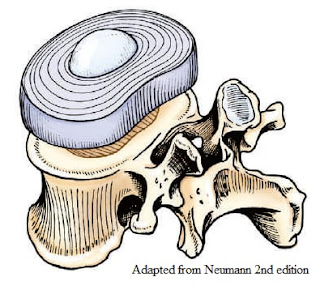

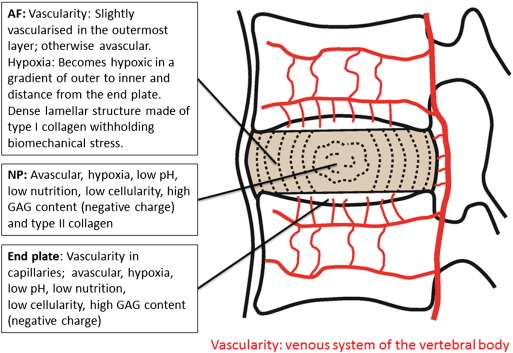


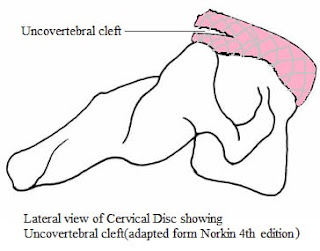
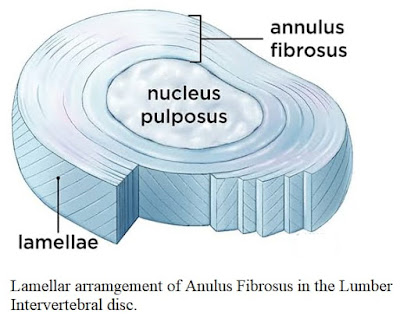
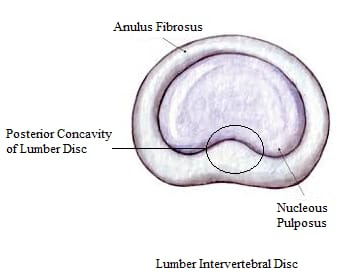

1 Comments
Explained in very systematic manner....i really appreciate it..and hoping for more topics😊
ReplyDeletePlease do not enter any spam link in the comment box